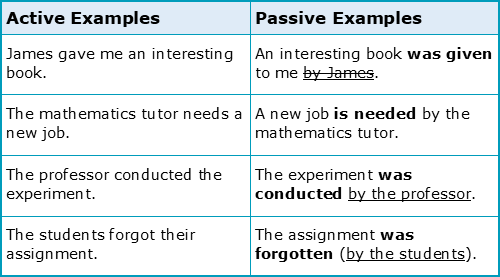How are active and passive constructions different?

This is the first of four chapters about Passive Constructions. To complete this reader, read each chapter carefully and then unlock and complete our materials to check your understanding.
– Introduce the passive concepts of the active and passive
– Explore how a knowledge of thematic relations and phrase functions is important when studying the passive
– Highlight the basic active and passive constructions
Before you begin reading...
-
video and audio texts
-
knowledge checks and quizzes
-
skills practices, tasks and assignments
Chapter 1
Whether you’re using English for general purposes or specific purposes, it’s highly likely that you’ll quickly encounter the terms ‘active’ and ‘passive’ – particularly when improving your knowledge of academic essays and presentations. Generally speaking, the active and passive voice are syntactic operations in which the doer and receiver of the action of the verb are moved within the clause. Recognising the active from the passive is relatively uncomplicated, and students often find it quite straightforward to form the passive voice too. However, where this subject becomes confusing (and warrants its own short reader) is in knowing exactly when to use passive constructions in speech and writing – particularly in academic contexts.

This four-chapter reader on passive constructions first explores the differences between active and passive structures, moving on in Chapter 2 to discussing the specific situations in which the passive should and should not be used – particularly in academic writing. Chapter 3 then introduces the various forms of the passive, providing advice for how to passivise both subjects and objects and providing example constructions using ‘get’ or ‘have’ instead of ‘be’. Finally, Chapter 4 introduces the most common student errors and explains how such mistakes can be corrected and avoided.
Why are thematic relations important?
Before we can explain what the passive voice is and how it differs from the active voice, it’s critical that we first understand a little about thematic relations (also known as semantic roles). Grammarians often categorise the different types of noun phrase that interact with their governing verb in a number of different ways. While students should have already heard of clausal phrase functions such as subjects, objects and adverbials, terms such as ‘agent’, ‘patient’ or ‘instrument’ – which are known as thematic relations – may at first be very unfamiliar. As can be seen in the diagrams below however, phrase functions and thematic relations are simply two ways of describing the same collections of words:


With passive constructions in mind, it’s important to remember that (1) the agent is broadly the doer of the action of the verb, and (2) the patient is the person, object or concept that undergoes or receives that action. This is important to remember because while it is the agent that’s the subject of the clause in the active voice, it is the patient that’s the subject in the passive:


What is the active voice?
Considering the phrase functions and thematic roles we’ve just explained, a simple definition of the active voice is that it generally describes a construction in which the subject of a transitive verb is the agent of that construction – with the patient being the receiving object. Importantly, active constructions such as ‘the professor conducted the experiment’ are by far the most common of the two structures in the English language, with over 90% of clauses in general prose and spoken English being active rather than passive.
What is the passive voice?
Conversely, the passive voice is when the subject of a transitive verb is the receiver of the action of that verb, acting as the patient. While passive constructions are not nearly as common as their active counterparts, they are still an important aspect of the English language and so should be perfected – particularly in academic writing. Some researchers in fact claim that passive constructions may account for around 15% of all transitive clauses in academic journals, reports and publications, making it therefore imperative that students are able to recognise, understand and use such constructions within their own academic assignments.
Thankfully, passive constructions are fairly easy to recognise so long as students are able to identify their four most common elements:
- Passive constructions use the verb ‘be’ and a past participle of the main verb
- Passive constructions include a transitive verb (intransitive verbs cannot be passive)
- The subject of such constructions is usually the patient (receiver) and not the agent (doer)
- The agent is introduced with the preposition ‘by’ or is omitted from the construction altogether
Remembering specifically these four elements, students should read the active and passive sentences below, attempting to spot and annotate the differences between these expressions:

Hopefully you should now feel more comfortable in identifying and understanding passive constructions in respect to their active counterparts. In Chapter 2 of this short reader on the passive voice, we next turn our attention to the many uses of the passive in both general and academic contexts. First complete the Chapter 1 activities and then consider moving on to the concepts of Chapter 2.
Downloadbles
Once you’ve completed all four chapters in this short reader about Passive Constructions, you might then wish to download our Chapter Worksheets to check your progress or print for your students. These professional PDF worksheets can be easily accessed for only a few Academic Marks.
Chapter 1 explores the topic: How are active and passive constructions different? Our Chapter 1 Worksheet (containing guidance, activities and answer keys) can be accessed here at the click of a button.
Chapter 2 explores the topic: How can the passive be used in academic English? Our Chapter 2 Worksheet (containing guidance, activities and answer keys) can be accessed here at the click of a button.
Chapter 3 explores the topic: Which 7 English passive constructions are useful? Our Chapter 3 Worksheet (containing guidance, activities and answer keys) can be accessed here at the click of a button.
Chapter 4 explores the topic: Which 5 passive errors are common with students? Our Chapter 4 Worksheet (containing guidance, activities and answer keys) can be accessed here at the click of a button.
To save yourself 3 Marks, click on the button below to gain unlimited access to all of our Passive Constructions Chapter Worksheets. This All-in-1 Pack includes every chapter, activity and answer key related to this topic in one handy and professional PDF.
Collect Academic Marks
-
100 Marks for joining
-
25 Marks for daily e-learning
-
100-200 for feedback/testimonials
-
100-500 for referring your colleages/friends